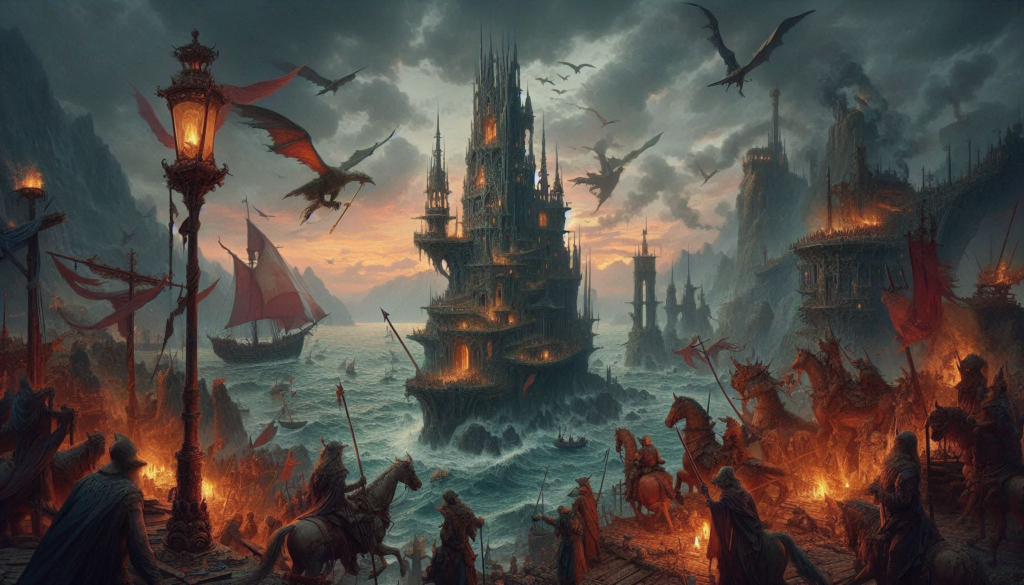If you’re a parent or a middle school reader exploring literature, you might have come across the term “Lexile level 1000.” But what does that mean? Essentially, a Lexile score of 1000 indicates that a book is suitable for advanced readers in grades 6 to 8. Let’s break down what to expect from these books in terms of plots, grammar, vocabulary, and sentence structure.

Fantasy and Sci-Fi
- The Hobbit by J.R.R. Tolkien
- Pros: Engaging adventure, relatable protagonist (Bilbo), introduces classic fantasy tropes.
- Cons: Language can be archaic for some readers; slower pacing in parts.
- Outcast of Redwall by Brian Jacques
- Pros: Rich world-building with talking animals, themes of friendship and bravery, exciting battles.
- Cons: May not appeal to readers uninterested in animal characters or fantasy settings.
- Hero and the Crown by Robin McKinley
- Pros: Strong female protagonist, themes of empowerment, blends adventure with romance.
- Cons: Some may find the pacing uneven; fantasy elements may require suspension of disbelief.
- Sabriel by Garth Nix
- Pros: Unique magic system, strong female lead, engaging mystery and suspense.
- Cons: Darker themes might not resonate with all middle school readers.
- The Golden Compass by Philip Pullman
- Pros: Intriguing alternate world, complex characters, combines adventure with philosophical questions.
- Cons: Some may find the plot complex or challenging; certain themes could be considered mature.
- Tales of Beedle the Bard by J.K. Rowling
- Pros: Fun stories set in the Harry Potter universe, moral lessons, whimsical storytelling.
- Cons: Short stories may leave readers wanting more; familiarity with Harry Potter enhances enjoyment.
- The Wizard of Oz by Frank L. Baum
- Pros: Classic story with memorable characters, themes of courage and friendship, colorful adventures.
- Cons: Some elements may feel outdated; younger readers might not relate to older societal norms presented.
- Fever Crumb by Philip Reeve
- Pros: Innovative steampunk setting, strong character development, fast-paced plot.
- Cons: May be challenging for those unfamiliar with steampunk conventions; complex narrative layers.
- The Looking Glass Wars by Frank Beddor
- Pros: Unique retelling of a classic tale with strong characters, engaging plot twists, action-packed.
- Cons: Some readers may find it less relatable than the original Alice stories; darker elements present.
- Shadow and Bone by Leigh Bardugo
- Pros: Strong world-building, intricate magic system, diverse characters and themes of power.
- Cons: Themes may feel mature or dark for some; slower start before action picks up.
- Red Rising by Pierce Brown
- Pros: Fast-paced and action-packed narrative, compelling protagonist facing oppression.
- Cons: Contains mature themes and violence; may not be suitable for all middle school readers.
- Eye of the Minds by James Dashner
- Pros: Engaging concept of virtual reality gaming, fast-paced plot with suspense.
- Cons: Some may find character development lacking; concepts of technology may be complex.

Historical Fiction
- Lizzie Bright and the Buckminster Boy by Gary D. Schmidt
- Pros: Addresses themes of friendship and social justice in an engaging narrative; richly developed characters.
- Cons: Historical context may require additional explanation for some readers; slower pacing in parts.
- Elijah of Buxton by Christopher Paul Curtis
- Pros: Unique perspective on slavery and freedom through a child’s eyes; humor blended with serious themes.
- Cons: Certain historical events may be challenging or heavy for younger audiences to grasp fully.
- Midwife’s Apprentice by Karen Cushman
- Pros: Strong female protagonist, rich historical detail about medieval life; relatable coming-of-age story.
- Cons: The setting and pace might feel slow for some modern readers; themes of social class are embedded subtly.
- An Ember in the Ashes by Sabaa Tahir
- Pros: Intriguing blend of fantasy and historical elements; well-developed characters facing moral dilemmas.
- Cons: Dark themes related to oppression and violence might be intense for some students.
- Rascal by Sterling North
- Pros: Touching coming-of-age story that focuses on nature and animals; relatable protagonist experiences growth.
- Cons: Some may find it less action-oriented compared to other adventure tales.
- War Horse by Michael Morpurgo
- Pros: Unique perspective on World War I from an animal’s viewpoint; emotional depth and beautifully written prose.
- Cons: War-related content could be heavy or difficult for sensitive readers to process.
- Island of the Blue Dolphins by Scott O’Dell
- Pros: Captivating survival story based on true events; themes of resilience and independence resonate strongly.
- Cons: The pacing might seem slow for those preferring constant action; some historical contexts might require additional discussion.
- The Boy in the Striped Pajamas by John Boyne
- Pros: Powerful narrative that explores friendship amidst a historical tragedy; thought-provoking discussions on ethics arise from reading it.
- Cons: Heavy subject matter related to the Holocaust may not be suitable for all middle school readers; requires maturity to process its themes.
This list provides a balanced view of each book’s potential appeal to middle school students while acknowledging any challenges they might face when reading them!

Understanding Lexile 1000: Grammar, Vocabulary, and Sentence Structure
Lexile measures are a popular way to evaluate the reading level of texts and readers alike. A Lexile score of 1000 indicates a text that is suitable for advanced middle school readers, typically ranging from grades 6 to 8. This score can help educators, parents, and students identify appropriate literature for their reading abilities. In this section, we will explore what a Lexile score of 1000 means from the perspectives of grammar, vocabulary, and sentence structure.
Grammar
At a Lexile level of 1000, readers will encounter more complex grammatical structures than they might in lower-level texts. Books at this level often feature:
- Varied Sentence Types: Readers will find a mix of simple, compound, and complex sentences. This variation challenges them to recognize different grammatical forms and understand how they can convey nuanced meanings.
- Advanced Conjunctions and Clauses: There is a greater use of subordinating clauses (e.g., “Although,” “Because”) and coordinating conjunctions (e.g., “and,” “but”) that contribute to sentence complexity.
- Passive Voice: While passive constructions are not the primary mode of expression in any writing, their inclusion in texts at this level introduces students to different ways to frame actions and subjects in sentences.
Understanding these grammar features helps advanced middle school readers comprehend deeper meanings within texts while also preparing them for higher-level writing.
Vocabulary
A Lexile score of 1000 signifies an increase in vocabulary complexity that students will encounter. Here’s what that looks like:
- Tiered Vocabulary: Readers will experience an array of words across three tiers—common (Tier 1), academic (Tier 2), and domain-specific (Tier 3). Texts at this level often contain Tier 2 words that are more abstract or less commonly used in everyday conversation (e.g., “analyze,” “consequence”).
- Contextual Clues: Advanced middle school readers will need to infer meanings from context as authors frequently use advanced vocabulary without explicit definitions. This practice encourages critical thinking about word meanings based on how they are used within the narrative.
- Figurative Language: Readers at this level will encounter metaphors, similes, idioms, and other figurative language forms that require interpretation beyond literal meanings. Such language enriches the reading experience but also demands greater analytical skills from the reader.
As students navigate through varied vocabulary levels, they build both their understanding and appreciation of language nuances.
Sentence Structure
At a Lexile level of 1000, sentence structure becomes increasingly sophisticated. This means:
- Longer Sentences: Texts often contain longer sentences that may be packed with information or multiple ideas. These sentences can challenge readers as they must maintain attention to follow along.
- Embedded Phrases: Readers will encounter embedded phrases and clauses that require careful parsing to understand relationships among ideas. For example, sentences may include non-essential clauses that provide additional information but can be set apart by commas.
- Complex Narratives: The interplay between sentence structure and narrative style is vital; texts often weave together multiple plot lines or perspectives. This layered storytelling requires readers to keep track of various threads, further enhancing their comprehension skills.
In conclusion, a Lexile score of 1000 indicates that readers will engage with complex grammatical structures, diverse vocabulary, and sophisticated sentence compositions. This challenge is ideal for advanced middle school students as it promotes growth in both comprehension and writing skills. Mastering these aspects will not only enhance their enjoyment of literature but also prepare them for the academic challenges ahead. By developing their grammar proficiency, expanding their vocabulary base, and navigating intricate sentence structures, young readers can unlock deeper levels of meaning in texts while becoming more articulate communicators themselves.

Understanding Lexile 1000: Characters, Plot, Subplots, and Themes
A Lexile score of 1000 indicates that a text is geared towards advanced middle school readers, typically between grades 6 and 8. At this level, readers can expect a deeper engagement with literature that features complex characters, intricate plots, multiple subplots, and rich themes. In this section, we will explore what a Lexile score of 1000 means for these crucial elements of storytelling.

Characters
At a Lexile level of 1000, character development becomes more nuanced and multifaceted. This complexity manifests in several ways:
- Depth and Complexity: Characters are often portrayed with depth, showcasing a range of emotions, motivations, and backstories. Readers will encounter protagonists who experience internal conflicts, moral dilemmas, or significant growth throughout the narrative.
- Relatable Flaws: Characters at this level often possess flaws that make them relatable to middle school readers. Their struggles may mirror real-life challenges faced by adolescents, such as identity crises, peer pressure, or family dynamics.
- Diverse Perspectives: A variety of characters representing different backgrounds and viewpoints adds richness to the story. Advanced middle school readers will benefit from understanding various cultural, social, and economic contexts that shape characters’ decisions and behaviors.

Plot
The plots of texts with a Lexile score of 1000 are generally more intricate and layered. This complexity allows for engaging narratives that captivate advanced middle school readers:
- Multi-Layered Storylines: Readers will encounter plots that contain multiple layers, interweaving primary story arcs with subplots that enhance the main narrative. This complexity encourages deeper comprehension as readers must track various threads.
- Unpredictable Twists: Advanced plots often feature unexpected developments or plot twists that keep readers guessing. This unpredictability adds excitement to the reading experience while also requiring critical thinking skills to anticipate character actions or outcomes.
- Conflict Resolution: Stories typically present various conflicts—internal (within a character) and external (between characters or societal forces)—that are resolved in thought-provoking ways. Readers may need to analyze how conflicts evolve throughout the narrative.
Subplots
Subplots play a significant role in texts at the Lexile 1000 level by enriching the overall story:
- Interconnected Narratives: Subplots often connect to the main plot or character arcs, enhancing themes or adding depth to character relationships. Readers learn to appreciate how secondary storylines can illuminate key aspects of the primary narrative.
- Character Development: Subplots provide opportunities for additional character growth and exploration of relationships. For instance, while the main plot may focus on an adventure or quest, a subplot might delve into a character’s friendship dynamics or family issues.
- Thematic Exploration: Subplots often serve as vehicles for exploring themes in more detail. They can provide contrast to the main plot or reinforce central ideas by highlighting different perspectives or experiences.

Themes
Themes in texts with a Lexile score of 1000 tend to be rich and multifaceted:
- Complex Themes: Advanced middle school readers can engage with complex themes such as identity, morality, love, loss, resilience, and social justice. These themes often require critical thinking and personal reflection from readers.
- Moral Dilemmas: Characters frequently face moral dilemmas that prompt discussions about right versus wrong. These situations encourage readers to consider their values and beliefs while examining the consequences of different choices.
- Societal Issues: Many texts at this level explore societal issues—such as inequality, prejudice, and belonging—challenging readers to think critically about the world around them. This exposure can foster empathy and awareness of diverse perspectives.
In conclusion, a Lexile score of 1000 signifies literature that is rich in character development, intricate plots with multiple subplots, and layered themes. Advanced middle school readers will find themselves immersed in complex narratives that encourage critical thinking and emotional engagement. By navigating these elements of storytelling, students not only enhance their reading skills but also gain valuable insights into human experiences and societal challenges—preparing them for thoughtful discourse both inside and outside the classroom.


Leave a Reply